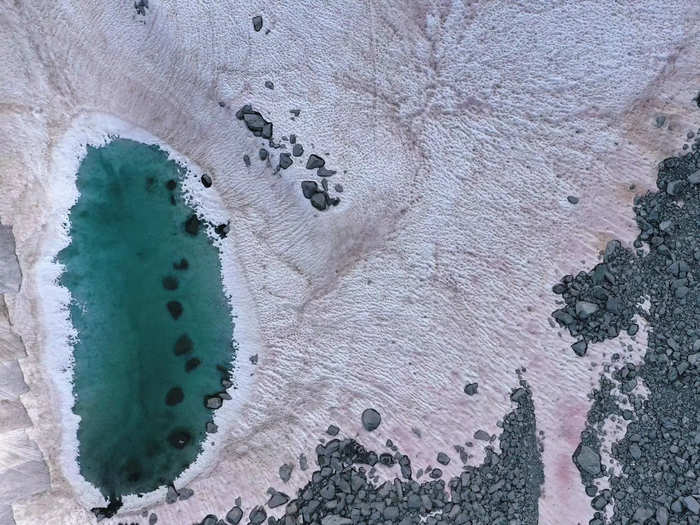
Lonar Lake in Maharashtra, India turns pinkTwitter/NandanDega

In July, scientists noticed that some of the glacial ice in the Alps was turning pink. They believe it is caused by algae that accelerate the effects of climate change.
Normally ice reflects more than 80% of the sun's radiation back into the atmosphere. However, once the algae appear, they darken the ice so that it absorbs the heat and melts more quickly.

In June, residents of Maharashtra started to notice Lonar Lake start to shift from its usual green to a pink hue. The reason for the change in colour is still benign investigated however scientists believe the most likely reason is that the microscopic life that lives within its waters is thriving in the high salt concentration.
Whats makes the Lonar Lake — also known as the Lonar Crater — special is that it was created when an asteroid struck Earth in its early years. It is the only “fresh” impact structure in basalt on Earth. Minerals found in the 1.2 kilometre wide lake’s soil have been determined to very similar to the minerals found in moon rocks brought back during the Apollo Program.

Antarctica didn’t just turn pink, but red, the ice around Ukraine’s Vernadsky Research Base got covered in ‘watermelon snow’ in March.
On the world’s most isolated continent, algae lie dormant in the snow and ice for most of the year. However, in 2020, Antarctica was witness to its hottest day on record when temperatures hit 18.3 degrees Celcius followed by a nine-day heatwave that melted 20% of the snow on one of its islands — Eagle Island.
Just like in the Italian Alps, the red snow reflects less sunlight causing the ice to melt faster. As a consequence, it produces even more bright algae.

During the nationwide lockdown in India, some of the water in its financial capital — Mumbai — was spotted turning pink. Scientists are still working on pinning down the exact cause but they believe the most likely culprit is the algal bloom. The salinity of the seawater combined with rising temperatures made for an ideal situation where algae could thrive.
The effects of pink algae as global temperatures increase aren’t only restricted to less sunlight being reflected back making the planet even hotter. It also blocks sunlight from reaching other aquatic organisms, brings down the oxygen levels in the water and could also be responsible for secreting toxins into the water.
 I spent $2,000 for 7 nights in a 179-square-foot room on one of the world's largest cruise ships. Take a look inside my cabin.
I spent $2,000 for 7 nights in a 179-square-foot room on one of the world's largest cruise ships. Take a look inside my cabin. Colon cancer rates are rising in young people. If you have two symptoms you should get a colonoscopy, a GI oncologist says.
Colon cancer rates are rising in young people. If you have two symptoms you should get a colonoscopy, a GI oncologist says. Saudi Arabia wants China to help fund its struggling $500 billion Neom megaproject. Investors may not be too excited.
Saudi Arabia wants China to help fund its struggling $500 billion Neom megaproject. Investors may not be too excited. Catan adds climate change to the latest edition of the world-famous board game
Catan adds climate change to the latest edition of the world-famous board game
 Tired of blatant misinformation in the media? This video game can help you and your family fight fake news!
Tired of blatant misinformation in the media? This video game can help you and your family fight fake news!
 Tired of blatant misinformation in the media? This video game can help you and your family fight fake news!
Tired of blatant misinformation in the media? This video game can help you and your family fight fake news!

Copyright © 2024. Times Internet Limited. All rights reserved.For reprint rights. Times Syndication Service.